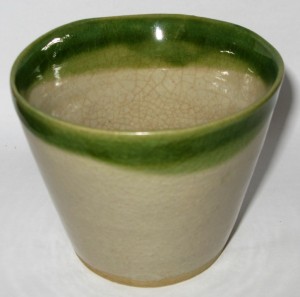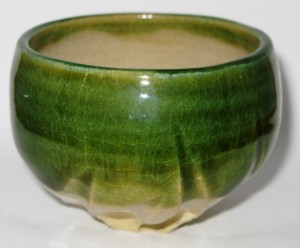Kamakura – Oribe
October 2006, Kamakura, Japan.
French version


In the workshop in Kamakura there are no machine, the bowls are turned by hand. I was taught to first dig the interior of the clay ball with both thumbs and then to start working inside and outside simultaneously. The shape obtained is then put to dry for a few hours in the sun or under a lamp in winter time. Once the clay has become harder, streaming the piece without deforming or breaking it becomes possible. The exterior receives then its final shape, and the inside gets wider and smoother while the structure becomes thinner and lighter. Giving all contours the same thickness helps limiting the deformation that may occur during firing.


On that day, the clay has a dark color. For my first work in the workshop, the master takes care of the enamelling. Oribe he asks in the evening while I am getting ready to go. « Hai, » Yes! I answer without being very sure of what he means, but that just seems so obvious. The following week, my surprise is great when I find white bowls lined with green (copper) on the top. These first bowls do not wear the brown patterns (iron oxide) that are usually characteristic of the style. This will come in later works.



First, I think that Oribe, the b gets pronounced v in Japan, means olive green! Wrong! Oribe is the name of the famous tea master, Furuta Oribe, who was born in the second half of the 16th century (1544-1615). The Oribe style is very popular in the workshop.


I create each bowl independently from the rest even if I make series around the same theme or the same combination of clay and enamel. I work shapes and colors according to the inspiration of the moment. Later, once the piece is done I compose pairs; some bowls once placed next to each others become obviously inseparable so great is the harmony they diffuse once together. In the morning, when I see them shining along the edge of the window touched by the first ray of sun, they have a happy look and as I leave for the office I envy their day.


More and more often I dream of a workshop where I could live from the work of my hands. I enjoy the company of the people even if all so focused on our work we seldom speak. We talk during the break, green tea and cookies time. We talk about the weather. Handling water, clay, fire and ink to create rather than manipulating men to use and finally break them. The further I go the more I think that one must be wary of those who can do nothing with their hands

Ce contenu a été publié dans
Japon,
Kamakura. Vous pouvez le mettre en favoris avec
ce permalien.












